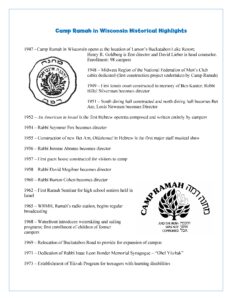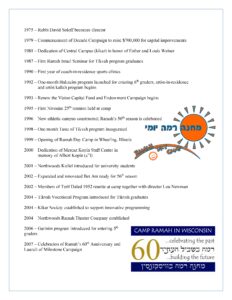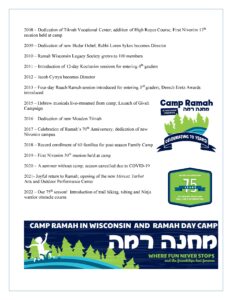Please enjoy a d’var Torah this week from Ari Weinstein. Ari is currently living in St. Louis Park, MN, where he grew up. He is looking forward to spending his 12th kayitz at Camp Ramah this summer as Rosh Nivonim.
Reflections on Parshiot Tazria and Metzora
by Ari Weinstein
Our Jewish chagim (holidays) meet us in whatever moment we find ourselves. Growing up in Minnesota, Passover – חג האביב (chag ha’aviv), the springtime holiday – could just have likely come in with flurries of snow as sprouts of reborn plants. As a Ramah camper and staff member, some years תשעה באב (Tisha B’av, the fast day on the ninth of Av) falls in our last week on the kikar, while other years it doesn’t arrive until after we’ve already left camp. For the first 18 years of my life Rosh Hashanah always found me at home with my family, and the most recent 6 rashei hashanah I’ve been away from home. No matter what the world looked like, the chagim came as scheduled in our Jewish calendar, and our experiences of the holiday may depend upon those circumstances.
This year, our Passover S’darim looked different than years past, unrelated to whether the ground was covered in snow or sprouting plants. They evolved into “Z’darim” over Zoom and we crowded around computers all over the country in order to celebrate together. It is up to us to bring as much open-mindedness and creativity as we can to engage with the holiday no matter where we are, what we’re feeling, or what’s happening in the world around us.
Our experience of a holiday may be heavily influenced by where we are and what we’re doing. The same is true for reading each week’s parashah in the Torah.
Last year when we read the parshiot of Tazria and Metzora, I was teaching a weekly parashah class for high school students. Our session about Tazria discussed the laws relating to mothers self-sequestering after giving birth through pretty critical lenses. The text of parashat Tazria includes instructions that women who give birth must isolate themselves from the community for long stretches of time:
“When a woman at childbirth bears a male, she shall be unclean seven days; she shall be unclean as at the time of her menstrual infirmity. On the eighth day the flesh of his foreskin shall be circumcised. She shall remain in a state of blood purification for thirty-three days: she shall not touch any consecrated thing, nor enter the sanctuary until her period of purification is completed. If she bears a female, she shall be unclean two weeks as during her menstruation, and she shall remain in a state of blood purification for sixty-six days.” (Leviticus 12:2-5)
When I discussed this with my students last year, we talked about the harshness of entering isolation after giving birth, and we investigated the ways that gender influenced this aspect of the parashah. Our conversation leaned toward a frustration with labeling a mother as “impure.”
Parashat Tazria continues to discuss rules pertaining to keeping people with leprosy away from the rest of the community, and the specifics of how to ensure their cleanliness is expanded upon in the subsequent parashah, Metzora:
“The one to be cleansed shall wash his clothes, shave off all his hair, and bathe in water; then he shall be clean. After that he may enter the camp, but he must remain outside his tent for seven days. On the seventh day he shall shave off all his hair—of head, beard, and eyebrows. When he has shaved off all his hair, he shall wash his clothes and bathe his body in water; then he shall be clean.” (14:8-9)
Furthermore, the person who is affected with leprosy is to engage in “guilt offering” sacrifices. When my students and I discussed this parashah last year, we discussed the unfairness of assigning guilt to someone who is ill, and imagined ways to look more compassionately at them.
This coming Shabbat, when we read parashiot Tazria and Metzora, my perception of the purification process is more nuanced. Concepts of health, distance, and time apart are palpable in new ways. Talking about stopping the spread of diseases in order to protect our communities is hyper-relevant and fresh – yet I’m still disturbed by the imperfections, through my twenty-first century eyes, of the rituals and expectations outlined in the parashiot.
I don’t feel that the state of the world has opened my eyes to a comfortable understanding of Biblical teachings about public health precautions (or what we think are meant to be related to public health). However, I’m able to compare the parashiot to more tangible and contemporary realities now than I was last year. Even if I’m still troubled by aspects of the text, the label of “impure,” or the treatment of sick individuals, I’m able to approach health-related isolation in a way I couldn’t have in April of 2019. This year, I’ll read the Torah’s instructions related to new mothers and people with leprosy with a still skeptical but far softer heart.
As we find ourselves living and learning our ways through an unfamiliar world, I hope that we move forward with greater sympathy, heightened compassion, and lots of care. We may encounter parashiot in the Torah or upcoming Jewish chagim with different appreciations, concerns, frustrations, and questions than in years past. What is most important is that we can synthesize these narratives and rituals we’ve inherited with all that we’re learning from our new realities. We have the opportunity to bring together inherited tradition and lived experience, and now more than ever before, exercise empathy toward ourselves, our loved ones, and our Judaism.
Shabbat shalom – may it be a peaceful and calm Shabbat.
Ari






